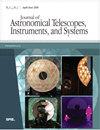用于AXIS探头的临界角透射光栅光谱仪的概念
IF 3.1
3区 工程技术
Q2 ENGINEERING, AEROSPACE
Journal of Astronomical Telescopes Instruments and Systems
Pub Date : 2023-04-01
DOI:10.1117/1.JATIS.9.2.024007
引用次数: 0
摘要
摘要先进x射线成像卫星(AXIS)是一种探测级任务概念,具有1 ~ 2弧秒阶点扩展函数的大采集区域。我们描述了一种可能的x射线光栅光谱仪(XGS),它可以添加到AXIS中,对望远镜本身进行最小的设计更改,并且只需花费总任务预算的一小部分。XGS将基于临界角传输(CAT)光栅,该技术在Arcus和Lynx公司已经成熟。使用详细的光线追踪,我们研究了几种提供有效面积和光谱分辨能力之间权衡的子孔径选择。根据光栅覆盖的全孔径大小(例如,17%至100%),我们发现在1.2至2.8 nm范围内,有效面积为1500 cm2时,可以实现高达λ / Δλ = 4000的高光谱分辨能力,有效面积为500 cm2时,可以实现λ / Δλ = 6000。CAT光栅的一个重要优点是它们在高能量下大部分是透明的,因此硬x射线仍然可以用于同时成像光谱。我们研究了不同的光栅尺寸和其他增强功能,但即使在基本配置中,XGS也可以添加到AXIS中以提供高分辨率光谱功能,从而开启一系列新的科学研究。我们的光线追踪表明,这个概念是成熟的,可以添加到AXIS对其他仪器的影响最小。我们将讨论一个由XGS促成的典型科学案例。本文章由计算机程序翻译,如有差异,请以英文原文为准。
Concept for a critical-angle transmission grating spectrometer for the AXIS probe
Abstract. The Advanced X-ray Imaging Satellite (AXIS) is a probe-class mission concept with a large collecting area with a point-spread-function of order 1 to 2 arcsec. We describe a possible X-ray grating spectrometer (XGS) that could be added to AXIS with minimal design changes to the telescope itself and costs a small fraction of the total mission budget. The XGS would be based on critical-angle transmission (CAT) gratings, a technology already matured for Arcus and Lynx. Using detailed ray-tracing, we investigate several options for subaperturing that provide a trade-off between effective area and spectral resolving power. Depending on how much of the full aperture is covered with gratings (e.g., 17% to 100%), we find a high spectral resolving power up to λ / Δλ = 4000 can be achieved with effective area of 1500 cm2 in the 1.2 to 2.8 nm range or λ / Δλ = 6000 with effective area 500 cm2. An important benefit of CAT gratings is that they are mostly transparent at high energies, and thus hard x-rays can still be used for simultaneous imaging spectroscopy. We study different grating sizes and other enhancements, but even in the basic configuration an XGS can be added to AXIS to provide high-resolution spectral capabilities, opening a range of new science investigations. Our ray-tracing shows that this concept is mature and can be added to AXIS with minimal impact on other instruments. We discuss one exemplary science case that would be enabled by the XGS.
求助全文
通过发布文献求助,成功后即可免费获取论文全文。
去求助
来源期刊

Journal of Astronomical Telescopes Instruments and Systems
Engineering-Mechanical Engineering
CiteScore
4.40
自引率
13.00%
发文量
119
期刊介绍:
The Journal of Astronomical Telescopes, Instruments, and Systems publishes peer-reviewed papers reporting on original research in the development, testing, and application of telescopes, instrumentation, techniques, and systems for ground- and space-based astronomy.
 求助内容:
求助内容: 应助结果提醒方式:
应助结果提醒方式:


